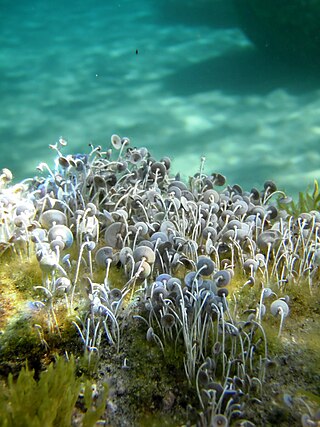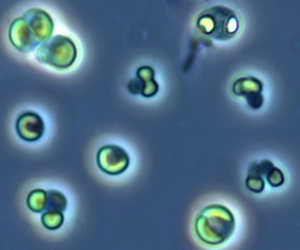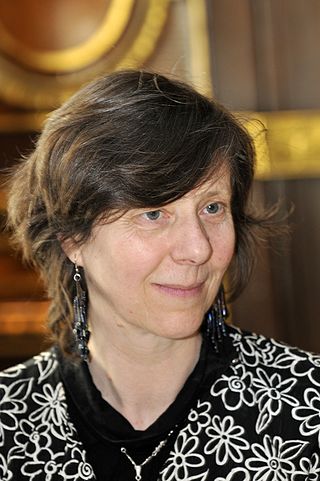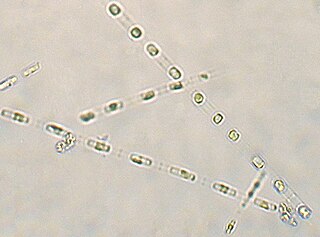Related Research Articles

Acetabularia is a genus of green algae in the family Polyphysaceae. Typically found in subtropical waters, Acetabularia is a single-celled organism, but gigantic in size and complex in form, making it an excellent model organism for studying cell biology. In form, the mature Acetabularia resembles the round leaves of a nasturtium, is 4 to 10 centimetres tall and has three anatomical parts: a bottom rhizoid that resembles a set of short roots; a long stalk in the middle; and a top umbrella of branches that may fuse into a cap. Unlike other giant unicellular organisms, which are multinucleate, members of this genus a single nucleus located in the rhizoid and allows the cell to regenerate completely if its cap is removed. The caps of two Acetabularia may also be exchanged, even from two different species. In addition, if a piece of the stem is removed, with no access to the nucleus in the rhizoid, this isolated stem piece will also grow a new cap.

Picocystis is a monotypic genus of green algae, the sole species is Picocystis salinarum. It is placed within its own class, Picocystophyceae in the division Chlorophyta.

Udotea is a genus of green algae in the family Udoteaceae.

Bolidophyceae is a class of photosynthetic heterokont picophytoplankton, and consist of less than 20 known species. They are distinguished by the angle of flagellar insertion and swimming patterns as well as recent molecular analyses. Bolidophyceae is the sister taxon to the diatoms (Bacillariophyceae). They lack the characteristic theca of the diatoms, and have been proposed as an intermediate group between the diatoms and all other heterokonts.
Gunnar Nygaard was a Danish phycologist, and a leading authority on the ecology and taxonomy of Danish phytoplankton. Nygaard completed his master's at University of Copenhagen, initially working at the Freshwater Biological Laboratory in Hillerød as a research stipendiary. From 1933 until his retirement in 1972 he was employed as a lecturer in the Danish grammar school system. Thereafter, he was provided an office at the Freshwater Biological Laboratory to facilitate his work. In recognition of his scientific contributions, the University of Copenhagen awarded him the degree dr. scient. honoris causa.
Grethe Berit Rytter Hasle was a Norwegian planktologist. Among the first female professors of natural science at the University of Oslo, she specialized in the study of phytoplankton.
Florenciella is a genus of heterokonts.

Pediastrum duplex is a species of fresh water green algae in the genus Pediastrum. It is the type species of the genus Pediastrum.
Skeletonema dohrnii is a diatom. Together with S. marinoi, this species has flattened extremities of the processes of the fultoportulae, which interlock with those of succeeding valves without forming knuckles. It is a species of the genus Skeletonema that can be found in many waters across the globe. In the coastal waters of South Korea, their cell diameters are about 3 to 6 micrometers.
Skeletonema marinoi is a diatom. Together with S. dohrnii, this species has flattened extremities of the processes of the fultoportulae, which interlock with those of succeeding valves without forming knuckles.
Cosmiodiscus is an extinct genus of diatom.

Christine Adair Maggs is a British phycologist. Formerly Executive Dean of the Faculty of Science & Technology at Bournemouth University, she was the first Chief Scientist of the Joint Nature Conservation Committee, retiring in 2022. She is now an independent non-executive Director of Ocean Harvest Technology https://oceanharvesttechnology.com/corporate-governance/board-of-directors/

Batrachospermaceae is a family of fresh water red algae (Rhodophyta). Genera within the Batrachospermaceae generally have a "Lemanea-type" life history with carpospores germinating to produce chantransia. Sporophyte phase with meiosis occurs in an apical cell to produce the gametophyte stage. Pit connections have two pit plug cap layers with the other layer enlarged. This family of freshwater red algae is uniaxial, meaning each filament with a single apical cell. The genera included within Batrachospermaceae are listed in the table below.

Michael Dominic Richard Guiry, is an Irish botanist, who specialises in phycology (algae). See for example the articles. He is the founder and director of the algal database, AlgaeBase.

Pyrenomonadaceae is a family of cryptomonads which includes three or four known genera. They are distinguished from other cryptomonads by their nucleomorphs being imbedded into the pyrenoid, and the presence of distinctive pigment phycoerythrin 545.

Timothy (Tim) John Entwisle, is an Australian botanist, much of whose research work is in phycology (algae). See for example the articles. He was awarded a Ph.D. from La Trobe University in 1986 for work on the taxonomy of Vaucheria.
Eva Konrad Hawkins was a Hungarian-born American biologist and college professor.
Greta Albrecht Fryxell was a marine scientist known for her work on the biology and taxonomy of diatoms. In 1996, she was elected a fellow of the American Association for the Advancement of Science.

Skeletonema costatum is a cosmopolitan centric diatom that belongs to the genus Skeletonema. It was first described by R. K. Greville, who originally named it Melosira costata, in 1866. It was later renamed by Cleve in 1873 and was more narrowly defined by Zingone et al. and Sarno et al. Skeletonemacostatum is the most well known species of the genus Skeletonema and is often one of the dominant species responsible for red tide events.
Kathleen "Kay" Margaret Cole was a Canadian phycologist, known as one of the world's leading experts in the cytology of marine algae. In 1998 the Canadian Botanical Society awarded her the George Lawson Medal for lifetime achievement.
References
- 1 2 3 "Medlin CV" (PDF). Retrieved October 31, 2021.
- ↑ Medlin, Linda Karen (1977). Light and electron microscopic studies of the nanobenthic diatom, Nitzschia ovalis Arnott, Section Lanceolatae, as compared to related forms, and the effect of temperature and salinity on its growth rate (Thesis). College Station, Tex.: Medlin. OCLC 3306295.
- ↑ "| Marine Biological Association". www.mba.ac.uk. Retrieved 2021-11-01.
- ↑ Fryxell, Greta A.; Laboratoire de cryptogamie, Paris; Association des amis des cryptogames, France (1981). "Chain forming diatoms: evidence of parallel evolution in Chaetoceros". Cryptogamie. Algologie. Paris: ADAC. 2.
- ↑ Medlin, Linda K.; Fryxell, Greta A. (1984). "Structure, Life History and Systematics of Rhoicosphenia (bacillariophyta). Iv. Correlation of Size Reduction with Changes in Valve Morphology of Rh. Genuflexa1". Journal of Phycology. 20 (1): 101–108. Bibcode:1984JPcgy..20..101M. doi:10.1111/j.0022-3646.1984.00101.x. ISSN 1529-8817. S2CID 85431562.
- ↑ Medlin, Linda; Elwood, Hille J.; Stickel, Shawn; Sogin, Mitchell L. (1988-11-30). "The characterization of enzymatically amplified eukaryotic 16S-like rRNA-coding regions". Gene. 71 (2): 491–499. doi:10.1016/0378-1119(88)90066-2. ISSN 0378-1119. PMID 3224833.
- ↑ Medlin, Linda K.; Elwood, Hille J.; Stickel, Shawn; Sogin, Mitchell L. (1991). "Morphological and Genetic Variation Within the Diatom Skeletonema costatum (bacillariophyta): Evidence for a New Species, Skeletonema pseudocostatum1". Journal of Phycology. 27 (4): 514–524. Bibcode:1991JPcgy..27..514M. doi:10.1111/j.0022-3646.1991.00514.x. ISSN 1529-8817. S2CID 84971128.
- ↑ Medlin, L. K.; Lange, M.; Baumann, M. E. M. (1994-05-01). "Genetic differentiation among three colony-forming species of Phaeocystis: further evidence for the phylogeny of the Prymnesiophyta". Phycologia. 33 (3): 199–212. Bibcode:1994Phyco..33..199M. doi:10.2216/i0031-8884-33-3-199.1. ISSN 0031-8884.
- ↑ Medlin, L. K.; Barker, G. L. A.; Campbell, L.; Green, J. C.; Hayes, P. K.; Marie, D.; Wrieden, S.; Vaulot, D. (1996-10-01). "Genetic characterisation of Emiliania huxleyi (Haptophyta)". Journal of Marine Systems. EHUX (Emiliania huxleyi). 9 (1): 13–31. Bibcode:1996JMS.....9...13M. doi:10.1016/0924-7963(96)00013-9. ISSN 0924-7963.
- ↑ Staay, Seung Yeo Moon-van der; Staay, Georg W. M. van der; Guillou, Laure; Vaulot, Daniel; Claustre, Herveé; Medlin, Linda K. (2000). "Abundance and diversity of prymnesiophytes in the picoplankton coμmunity from the equatorial Pacific Ocean inferred from 18S rDNA sequences". Limnology and Oceanography. 45 (1): 98–109. Bibcode:2000LimOc..45...98M. doi: 10.4319/lo.2000.45.1.0098 . ISSN 1939-5590. S2CID 86227557.
- ↑ Medlin, Linda K.; Lange, Martin; Nöthig, Eva-Maria (2000). "Genetic diversity in the marine phytoplankton: a review and a consideration of Antarctic phytoplankton". Antarctic Science. 12 (3): 325–333. Bibcode:2000AntSc..12..325M. doi:10.1017/S0954102000000389. ISSN 1365-2079. S2CID 85185098.
- ↑ Medlin, L. K.; Metfies, K.; Mehl, H.; Wiltshire, Karen; Valentin, K. (2006). "Picoeukaryotic Plankton Diversity at the Helgoland Time Series Site as Assessed by Three Molecular Methods". Microbial Ecology. 52 (1): 53–71. Bibcode:2006MicEc..52...53M. doi:10.1007/s00248-005-0062-x. ISSN 0095-3628. PMID 16703447. S2CID 23906313.
- ↑ Sáez, Alberto G.; Probert, Ian; Geisen, Markus; Quinn, Patrick; Young, Jeremy R.; Medlin, Linda K. (2003-06-10). "Pseudo-cryptic speciation in coccolithophores". Proceedings of the National Academy of Sciences. 100 (12): 7163–7168. Bibcode:2003PNAS..100.7163S. doi: 10.1073/pnas.1132069100 . ISSN 0027-8424. PMC 165847 . PMID 12759476.
- 1 2 Medlin, Linda K.; Kaczmarska, Irena (2004-05-01). "Evolution of the diatoms: V. Morphological and cytological support for the major clades and a taxonomic revision". Phycologia. 43 (3): 245–270. Bibcode:2004Phyco..43..245M. doi:10.2216/i0031-8884-43-3-245.1. ISSN 0031-8884. S2CID 83631828.
- ↑ Not, Fabrice; Valentin, Klaus; Romari, Khadidja; Lovejoy, Connie; Massana, Ramon; Töbe, Kerstin; Vaulot, Daniel; Medlin, Linda K. (2007-01-12). "Picobiliphytes: A Marine Picoplanktonic Algal Group with Unknown Affinities to Other Eukaryotes". Science. 315 (5809): 253–255. Bibcode:2007Sci...315..253N. doi:10.1126/science.1136264. PMID 17218530. S2CID 22285394.
- ↑ Seenivasan, Ramkumar; Sausen, Nicole; Medlin, Linda K.; Melkonian, Michael (2013-03-26). "Picomonas judraskeda Gen. Et Sp. Nov.: The First Identified Member of the Picozoa Phylum Nov., a Widespread Group of Picoeukaryotes, Formerly Known as 'Picobiliphytes'". PLOS ONE. 8 (3): e59565. Bibcode:2013PLoSO...859565S. doi: 10.1371/journal.pone.0059565 . ISSN 1932-6203. PMC 3608682 . PMID 23555709.
- ↑ Taylor, Joe D.; Kegel, Jessica U.; Lewis, Jane M.; Medlin, Linda K. (2014-07-01). "Validation of the detection of Alexandrium species using specific RNA probes tested in a microarray format: Calibration of signal using variability of RNA content with environmental conditions" (PDF). Harmful Algae. 37: 17–27. doi:10.1016/j.hal.2014.05.001. ISSN 1568-9883.
- ↑ Medlin, Linda K.; Orozco, Jahir (2017). "Molecular Techniques for the Detection of Organisms in Aquatic Environments, with Emphasis on Harmful Algal Bloom Species". Sensors. 17 (5): 1184. Bibcode:2017Senso..17.1184M. doi: 10.3390/s17051184 . PMC 5470929 . PMID 28531156.
- ↑ Gescher, Christine; Metfies, Katja; Medlin, Linda K. (2008-06-01). "The ALEX CHIP—Development of a DNA chip for identification and monitoring of Alexandrium". Harmful Algae. 7 (4): 485–494. doi:10.1016/j.hal.2007.11.001. ISSN 1568-9883.
- ↑ "Artikkel: Group 6: Cellular and Molecular biology". Norwegian Academy of Science and Letters. Retrieved 2021-11-01.
- ↑ Sarno, Diana; Kooistra, Wiebe H. C. F.; Medlin, Linda K.; Percopo, Isabella; Zingone, Adriana (2005). "Diversity in the Genus Skeletonema (bacillariophyceae). Ii. an Assessment of the Taxonomy of S. Costatum-Like Species with the Description of Four New Species1" (PDF). Journal of Phycology. 41 (1): 151–176. Bibcode:2005JPcgy..41..151S. doi:10.1111/j.1529-8817.2005.04067.x. ISSN 1529-8817. S2CID 53679188.
- ↑ "Provasoli Award". Phycological Society of America. Retrieved 2021-11-01.
- ↑ Sims, Patricia A.; Mann, David G.; Medlin, Linda K. (2006-07-01). "Evolution of the diatoms: insights from fossil, biological and molecular data". Phycologia. 45 (4): 361–402. Bibcode:2006Phyco..45..361S. doi:10.2216/05-22.1. ISSN 0031-8884. S2CID 55058077.url=https://doi.org/10.2216/i0031-8884-39-1-19.1
- ↑ "International Phycological Society - Past Winners Tyge Christensen Prize". intphycsociety.org.
- ↑ "Pioneering MBA Associate Research Fellow awarded lifetime achievement award". October 13, 2021. Archived from the original on November 4, 2021.